Best Mobile Web Development Tools: Features and Benefits
By Alex Carter on September 23, 2024
Developing mobile-friendly applications requires the right tools to ensure efficiency, performance, and compatibility across devices. Mobile web development tools simplify coding, testing, and deployment, allowing developers to build responsive applications without having to create everything from scratch. These tools provide features such as integrated development environments (IDEs), pre-built templates, API integration, data synchronization, and debugging capabilities.
Selecting the right tool depends on project requirements, whether it’s native development, cross-platform compatibility, or low-code solutions.
What is a Mobile App Development Tool?
Building a mobile app takes time and requires more than just writing code for a few hours. A key part of the process is using a mobile app development tool, which helps developers create apps more efficiently. These tools provide features like integrated development environments (IDEs), no-code options, pre-built templates, APIs, data synchronization, and analytics. They make it easier to connect with backend services such as push notifications while speeding up development. Many also offer a visual interface and support for hardware compatibility, making the overall workflow more manageable.
Best Tools for Mobile Web Development and Design
Effective mobile web development requires the right tools to simplify coding, testing, and design. Below are some of the best platforms for building and optimizing mobile-friendly websites and web applications.
Adobe Dreamweaver

Originally developed by Macromedia in 1997, Adobe Dreamweaver is a web design and development program that was subsequently purchased by Adobe. Because it is compatible with both Windows and macOS, developers may use technologies like CSS and JavaScript to create adaptable webpages.
Key Features:
- Code editor with syntax highlighting for multiple languages, including HTML, JavaScript, and WML;
- HTML5 support and code hinting for faster development;
- Integration with PhoneGap Build and jQuery Mobile for mobile app development;
- Multi-screen preview to test designs across different devices;
- Available in multiple languages.
Microsoft Visual Studio
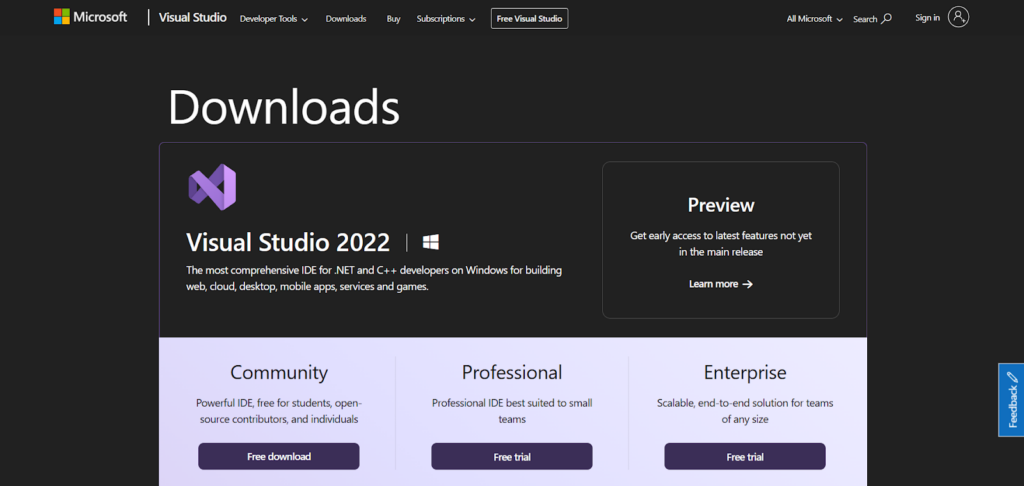
For cross-platform mobile development, especially with Xamarin, Microsoft Visual Studio offers a versatile integrated development environment (IDE). Those developers who are skilled in C# prefer it over other programming languages like Swift, Objective-C, or Kotlin. The platform enables cross-platform application development while allowing developers to maintain a native user interface and share business logic across different platforms. It is also well-suited for those with experience in desktop applications, as it provides a familiar development environment with robust tools and integrations.
Key Features:
- Code editor with syntax highlighting, code completion, and bookmarks;
- Advanced debugging tools are available at both the source and machine levels;
- Multiple visual designers for application design (Windows Forms, WPF, Class Designer, and more);
- Built-in testing tools such as Unit Testing, Test Explorer, IntelliTest, and Fakes;
- Extensive support for custom extensions and integrations;
- Available in 13 languages.
Blisk
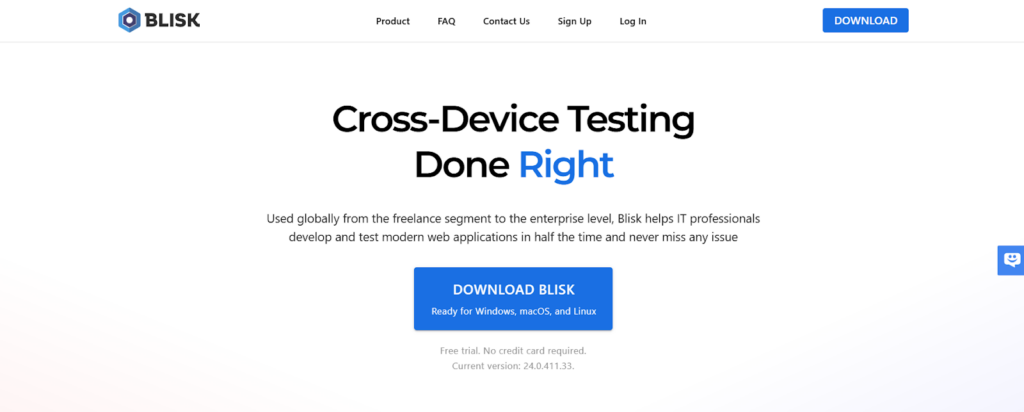
Blisk is a Chromium-based web browser launched in 2016, designed specifically for mobile web development and testing. It enables developers to optimize websites for different screen sizes without requiring multiple physical devices.
Key Features:
- Minimalist side-by-side view for real-time design previews;
- Browsing mode & Developer mode for fast testing and debugging;
- Device emulation for multiple screen sizes without needing actual devices;
- JavaScript error monitoring with categorized notifications;
- Integrated screen-capturing tools (screenshots and screen recording);
- Simultaneous scrolling across project and emulated devices;
- Blisk DevTools for quick page edits and debugging;
- Automated local code tracking with real-time page refreshing;
- Integration with command-line tools for customized development;
- Incognito mode for private browsing.
Best Tools for Mobile App Development
Choosing the right mobile app development tool starts with understanding specific requirements and expectations. The most effective tools are specialized, focusing on a limited set of tasks but handling them with precision. They also prioritize high performance, ensuring speed and efficiency throughout the development process. Additionally, collaboration-friendly tools facilitate teamwork by supporting real-time edits, notifications, and well-documented code. Combining mobile app development with website performance optimization helps maintain consistency and efficiency across different platforms.
The following is a full summary of the best mobile app development tools, including their key use cases and potential drawbacks.
Xcode
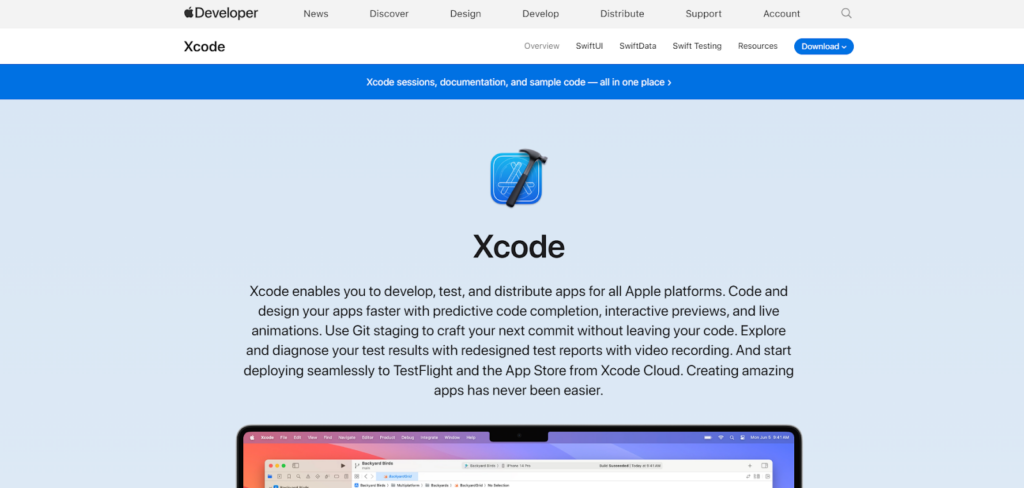
Xcode is Apple’s official development tool for building iOS apps. It supports various programming languages like Swift, Objective-C++, Python, and Java. Developers use Xcode for coding, testing, and optimizing applications within a structured environment. It also includes features for project management, code tracking, and team collaboration, making it a complete solution for iOS app development.
However, Xcode is not suitable for Android development, as it is exclusively designed for Apple’s platform. It is also not ideal for cross-platform app development, as it lacks built-in support for non-iOS platforms. Additionally, projects requiring advanced UI customization or third-party integrations may find Xcode limiting compared to other development tools that offer broader compatibility.
As Apple’s official IDE, Xcode guarantees full compatibility with iOS. While third-party alternatives exist, they do not offer the same level of support, stability, or system integration.
Android Studio

Android Studio is Google’s official integrated development environment (IDE) for Android app development, built on the IntelliJ IDEA platform. It is widely used for creating native Android applications, offering tools that simplify coding, debugging, and optimization. The IDE supports various testing frameworks and automation features, allowing developers to ensure app stability and performance before deployment. Android Studio also includes an emulator that enables testing on virtual devices, reducing the need for physical hardware during development. Additionally, it integrates with Google Cloud services, making it easier to manage backend functionalities and cloud-based operations.
Compared to older alternatives like Eclipse, Android Studio offers better refactoring tools, an improved emulator, and a more user-friendly interface. Its official status ensures compatibility with Android devices.
Unity
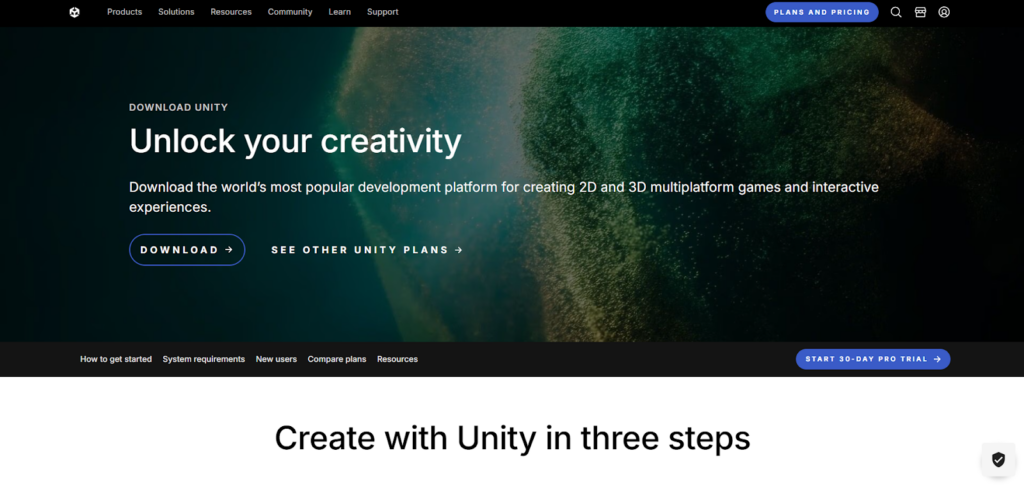
Unity is a game engine used for developing 2D, 3D, virtual reality (VR), and augmented reality (AR) games across multiple platforms. It is widely used for creating games with detailed graphics and smooth performance. Developers working with Unity can build games for various devices while using the C# programming language. The engine includes a broad set of tools and resources, making it a common choice for both independent developers and larger studios working on interactive applications.
Although Unity is useful for game development, it is not designed for 3D model creation, requiring external software like 3DS Max or Photoshop for asset design. It is also not suitable for general graphic design projects, as its focus is on game development rather than creative design. Unity’s rendering capabilities can make it resource-intensive, which may limit its practicality for non-gaming applications that do not need real-time graphics processing.
With a vast asset library and a strong developer community, Unity is one of the most widely used game engines, offering robust support for both indie and large-scale projects.
Corona SDK
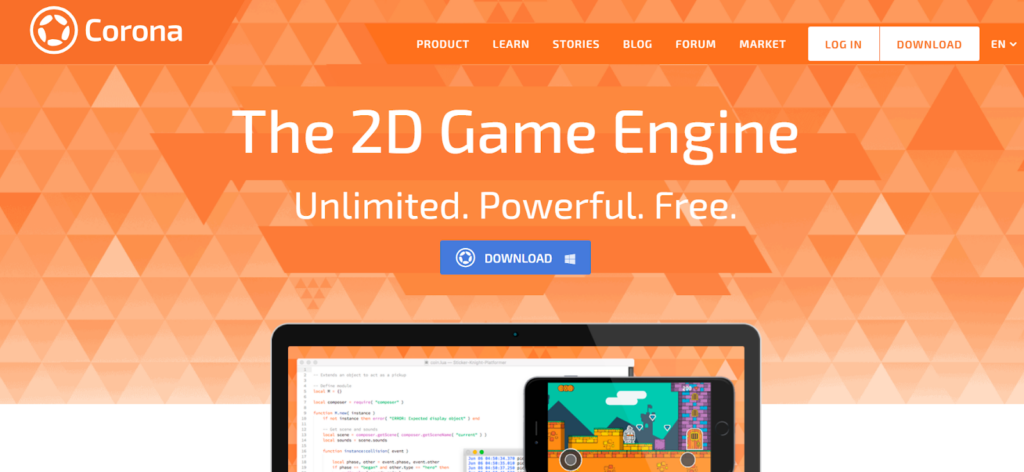
Corona is an open-source software development kit (SDK) designed for lightweight 2D game development across multiple platforms. It is often used for creating simple games such as puzzles and quizzes, making it a suitable option for developers looking to build mobile games with minimal resource requirements. The SDK is particularly useful for MVP development and prototyping, allowing developers to quickly test concepts before committing to full-scale production. It also supports live build testing and real-time documentation, which helps simplify the development process and improve efficiency.
Corona is ideal for 2D game production, but it is not intended to create 3D games. Developers working on graphically heavy projects may find its capabilities restricted, particularly when compared to engines such as Unity, which have a wider asset catalog and more comprehensive customization possibilities.
Each development tool has its strengths, making them suitable for different project requirements. The right choice depends on factors like platform compatibility, development speed, and performance needs.
Best Mobile Testing Tools for Reliable App Performance
Effective mobile app testing relies on robust tools that support automation, collaboration, and bug tracking. Testers need to monitor real-time updates, manage test cases, log issues, and assess performance. Below are some of the most widely used mobile testing tools, along with their applications and limitations.
TestFlight
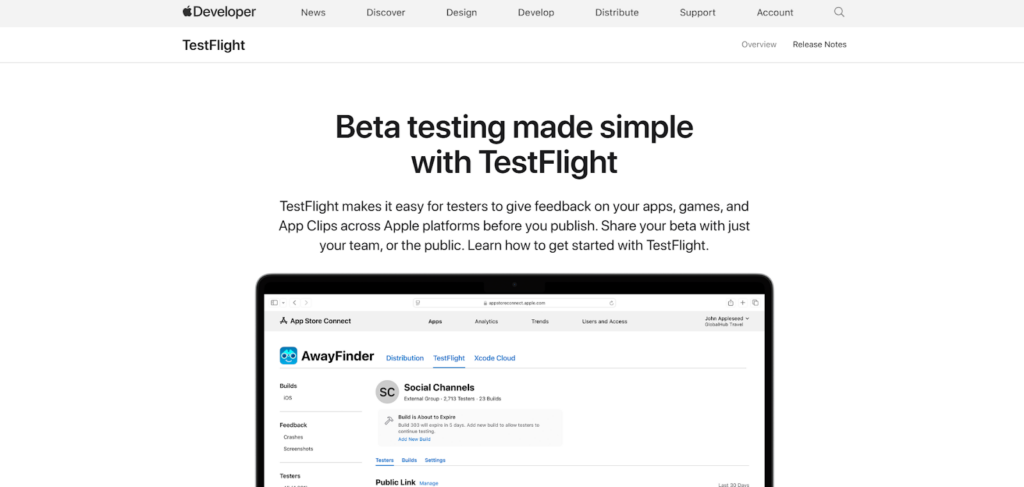
TestFlight is Apple’s official beta-testing platform for iOS applications. Initially available for Android, it now exclusively supports Apple’s platform.
Best for:
- Beta testing with external users and test communities;
- Collaboration among developers within the iOS Developer Program;
- Managing builds, tracking app performance, and detecting issues automatically.
Not suited for:
- Android or non-iOS app development;
- Early-stage projects not yet prepared for beta testing;
- Teams outside Apple’s platform that don’t use Xcode or iTunes Connect.
As part of Apple’s development environment, TestFlight allows testing within iOS. It supports both internal and external testers while ensuring compliance with App Store guidelines.
Espresso
Espresso is Google’s recommended UI testing framework for Android, designed for efficient automated interface testing.
Best for:
- Automating UI tests for Android applications;
- Click-testing to validate button functionality;
- White-box testing, where knowledge of the app’s codebase enhances test accuracy.
Not suited for:
- iOS UI testing (XCUITest is the preferred alternative);
- Teams with no prior automation experience (Espresso is simpler than some tools but still requires UI testing knowledge);
- Multi-platform testing (test scripts cannot be shared across iOS and Android).
Espresso integrates with Android Studio, offering an intuitive and efficient way to automate UI testing for Android apps, with strong documentation and support.
TestComplete
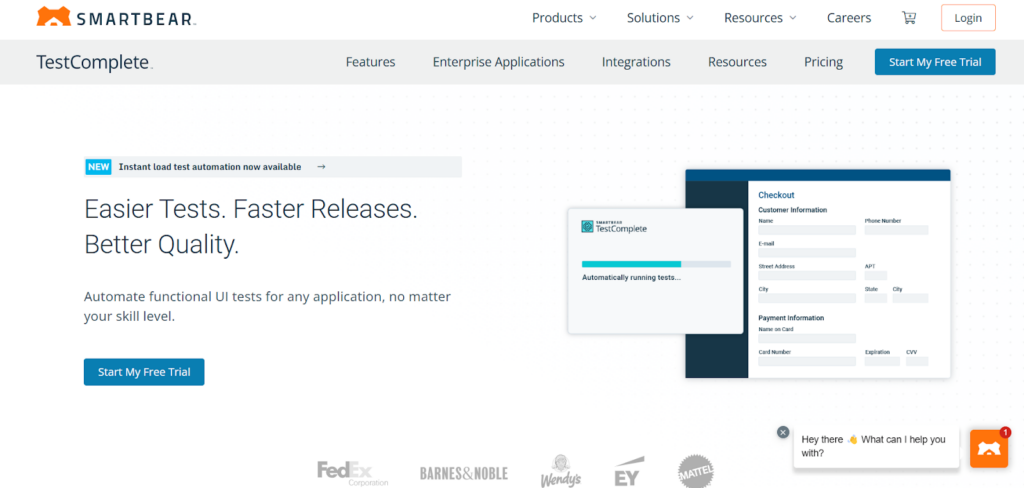
TestComplete is a cross-platform automation tool designed for functional testing across Android, iOS, web, and desktop applications.
Best for:
- Functional testing of iOS and Android apps;
- Keyword-driven testing, where test cases are mapped to predefined actions;
- Regression testing to verify functionality after updates.
Not suited for:
- UI testing, as it prioritizes functionality over design consistency;
- Projects requiring full native performance, as OS-specific nuances may not always be addressed.
Its versatility extends beyond mobile app testing, making it a valuable tool for web and desktop projects. Once teams adapt to its interface, it becomes a reliable asset for automated testing across multiple platforms.
CocoaPods
CocoaPods is a widely used dependency manager for iOS applications, simplifying code integration and library management.
Best for:
- Managing dependencies in open-source and custom iOS projects;
- Unifying frameworks and maintaining syntax consistency across codebases;
- Enhancing security by incorporating pods that detect and fix vulnerabilities.
Not suited for:
- Projects requiring full native performance with minimal dependencies;
- Multi-platform development, as excessive dependency integration may lead to technical complexity.
It simplifies dependency management for iOS applications, particularly for developers familiar with Ruby. Its structured approach simplifies framework integration, making it a preferred choice for iOS development teams.
Top Mobile App Development Platforms for Faster and Scalable Development
Mobile app development platforms and frameworks simplify the process by reducing the need for developers to build everything from the ground up. Even experienced teams benefit from structured templates, pre-built components, and optimized workflows. Below are some of the most effective platforms for mobile development, along with their ideal use cases and limitations.
Firebase
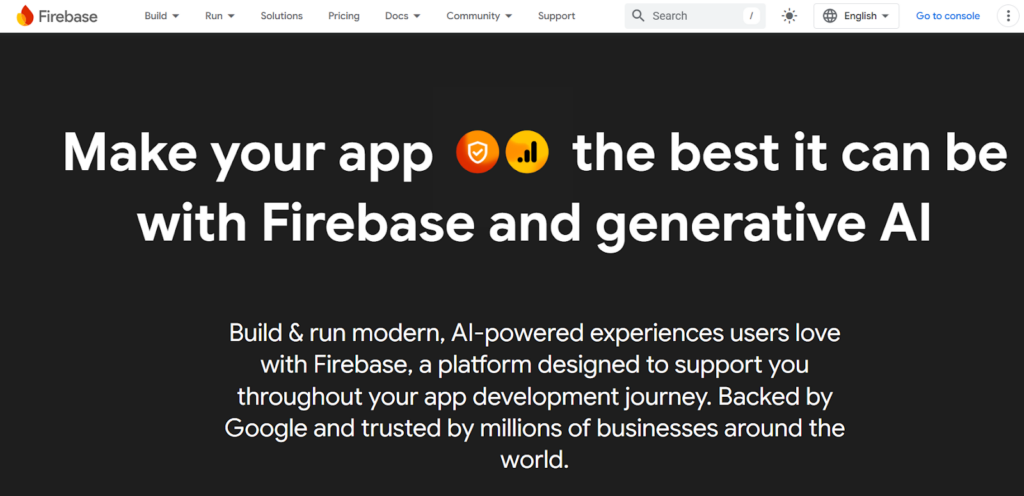
Firebase is a development platform that provides tools for app analytics, file storage, push notifications, data processing, and user authentication. It simplifies backend development, allowing teams to focus on building core features instead of managing infrastructure. The platform is particularly useful for onboarding new developers, as it includes structured documentation and project templates that help simplify the development process. It also supports personalization through advanced analytics, enabling businesses to track user behavior and optimize conversion rates. Additionally, Firebase facilitates deployment by simplifying beta testing, managing version rollouts, and monitoring app performance.
While Firebase offers extensive functionality, it may not be suitable for businesses that prefer to operate independently of Google Cloud services. Enterprise-level projects requiring a high degree of customization and complete control over data may find its limitations restrictive. Teams without prior experience in cloud-based development may also face challenges, as support response times from Google Cloud can sometimes be slow.
Firebase uses Google’s scalable infrastructure, offering cloud-based solutions for app development. It’s ideal for projects that require a reliable backend without the overhead of building one from scratch.
Flutter
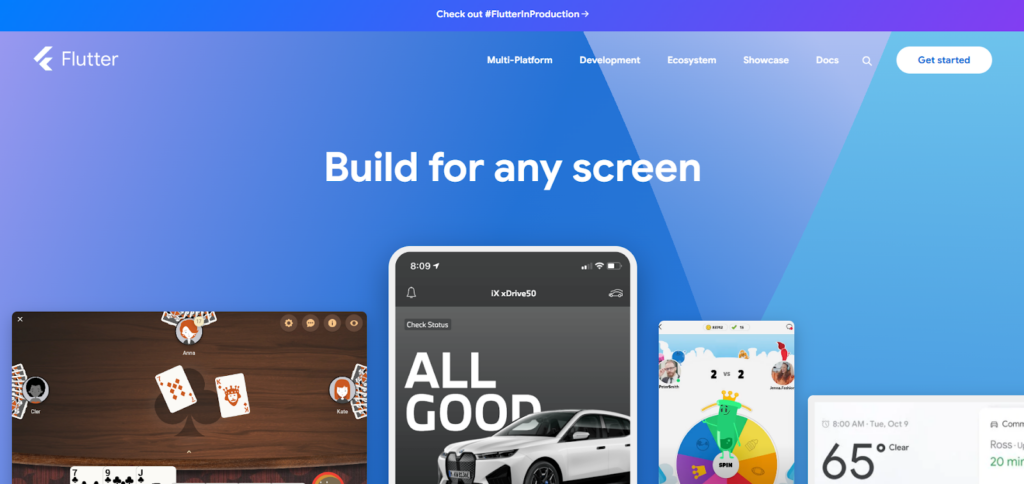
Flutter is Google’s open-source UI toolkit designed for developing applications on Android and iOS. It simplifies user interface development by offering a set of pre-built widgets, smooth animations, and fast rendering. The framework is particularly useful for MVP development, as its hot reload feature allows developers to make instant updates, speeding up the iteration process. It is also well-suited for lightweight applications such as e-commerce platforms, quizzes, and other interactive experiences. Additionally, Flutter provides a middle ground between native and cross-platform development, delivering better performance than traditional hybrid frameworks.
While Flutter is effective for building mobile applications, it is not ideal for projects that require complex internal logic beyond UI components. Developers planning to scale their applications into web-based platforms may also find limitations, as Flutter is primarily designed for mobile development.
Unlike UI frameworks that rely on JavaScript, Flutter uses Dart, which compiles directly into native machine code. This results in better performance and a smoother user experience compared to many hybrid alternatives.
Ionic
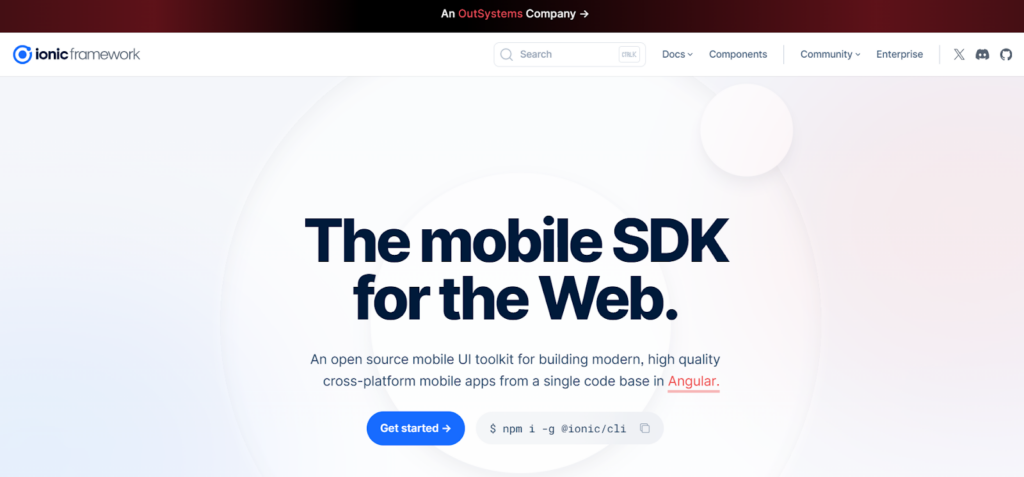
Ionic is a cross-platform framework that allows for rapid development across Android, iOS, and the web. It includes pre-built UI components, themes, and templates, making it a widely used option for hybrid app development. The framework is particularly well-suited for applications that require web compatibility, such as email clients, e-commerce platforms, messaging apps, and tracking tools. Developers with experience in Angular or React can quickly adapt to Ionic, as it integrates with these technologies. It is also a practical choice for MVP development, providing a fast and cost-effective way to build and test applications, even though it does not offer fully native performance.
Ionic is not the best option for applications that require highly customized user interfaces, such as social media platforms, VR/AR apps, or high-performance games. Large-scale enterprise projects that demand extensive customization may also face limitations, as JavaScript-based frameworks like Ionic can introduce performance constraints compared to fully native solutions.
Ionic allows web code to be repurposed for mobile applications, making development more efficient. For projects that don’t require advanced native functionalities, it offers a faster and more affordable alternative to fully native development.
Xamarin
Owned by Microsoft, Xamarin is a widely used open-source mobile application development platform that enables developers to create high-performance Windows, Android, and iOS apps using C# and .NET.
Xamarin offers a range of tools, programming languages, and libraries that simplify mobile app development. It also allows developers to reuse existing data access and business logic layers across multiple platforms, improving efficiency and reducing development time.
Key Features of Xamarin and the .NET Platform:
- C# programming language – Includes compilers for efficient coding;
- Base libraries – Support for handling strings, dates, file operations, and input/output functions;
- Multi-platform development tools – Compatible with Windows, Linux, macOS, and Docker.
Optimizing Development with Automation, Continuous Integration, and Delivery
Maintaining an efficient workflow beyond project completion requires robust automation, continuous integration, and continuous delivery (CI/CD). The following tools help simplify development, testing, and deployment, improving efficiency and collaboration.
Jenkins
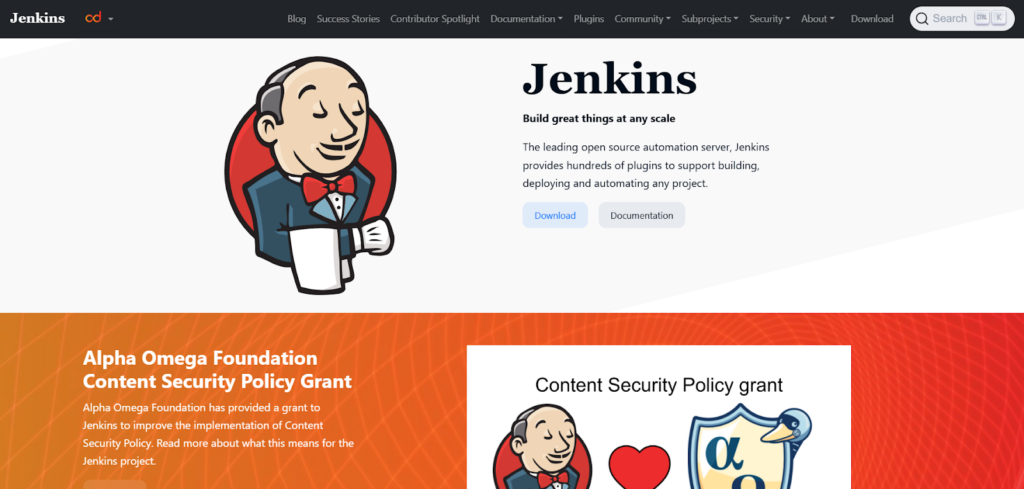
Jenkins is a widely used CI/CD platform that automates code updates, deployments, test execution, and pull request management.
Best for:
- DevOps teams – Unifies development, testing, and operations with real-time updates;
- Large projects – Enhances task visibility, tracks issues, and improves team collaboration;
- Code maintenance – Automates refactoring and manages technical debt effectively.
Not suited for:
- UI testing automation – Complex test scenarios require dedicated UI testing tools;
- Teams without DevOps expertise – Requires proper configuration to avoid unnecessary complexity.
Jenkins centralizes development, testing, and deployment, making it a key tool for managing test cases, tracking code quality, and monitoring team contributions.
Fastlane
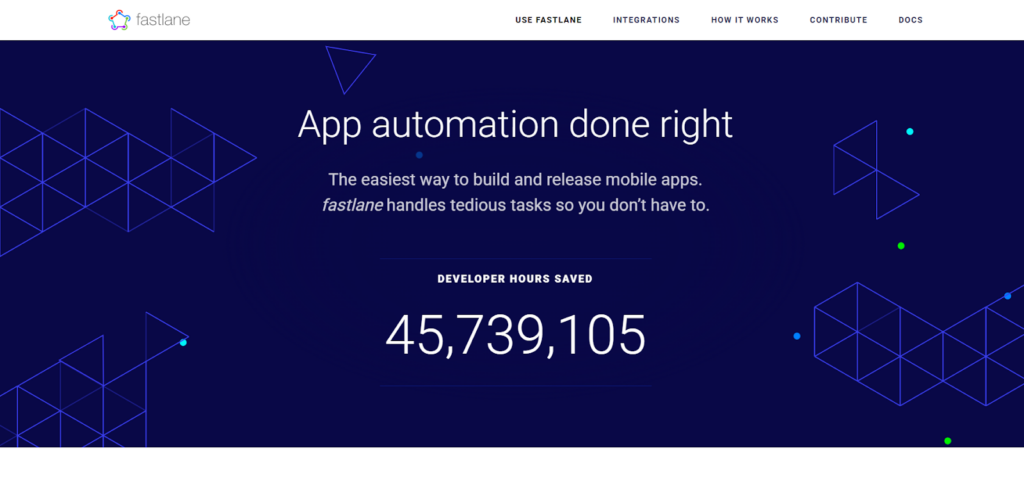
Fastlane automates software releases, beta testing, and deployment, handling repetitive tasks such as screenshot generation, documentation updates, and release management.
Best for:
- Projects using Jenkins – Complements Jenkins for managing beta releases and deployments;
- DevOps teams – Bridges development and operations by automating updates and providing real-time insights;
- Agile teams – Ideal for frequent small releases instead of large, infrequent updates.
Not suited for:
- Xcode integration – While possible, combining Fastlane with Xcode may introduce compatibility challenges;
- Projects without full automation needs – In some cases, manual updates can be more efficient than setting up an entire automation pipeline.
It integrates with various CI/CD platforms, including Jenkins, enabling teams to automate releases without relying on external storage solutions.
Bitrise
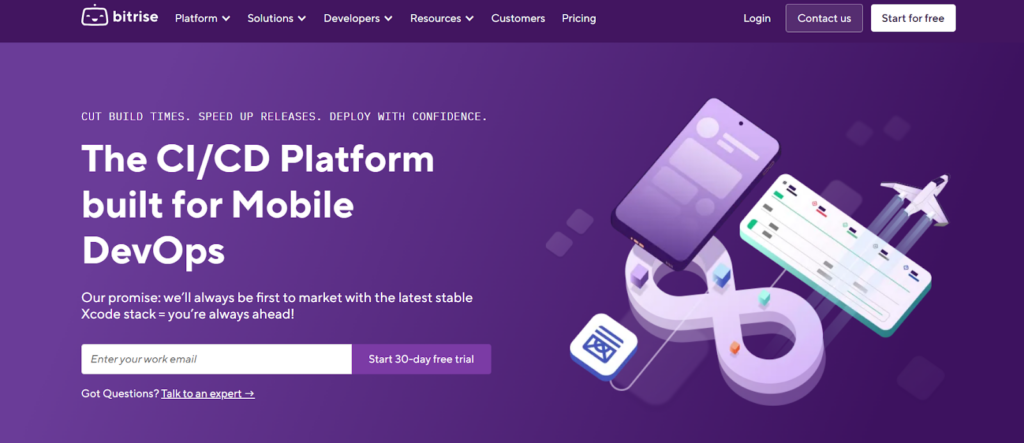
Bitrise is a mobile-centric continuous integration platform designed for automating builds, collecting analytics, and improving team collaboration.
Best for:
- High-performance projects – Provides flexible performance options, from 2GB to 16GB RAM.
- Teams new to CI/CD – Offers guided workflows to simplify deployment and testing.
- Mobile UI testing – Optimized for automated UI testing on mobile devices, an area often overlooked by general CI tools.
Not suited for:
- Teams needing a universal CI/CD solution – Unlike Jenkins, Bitrise is more mobile-focused and may not meet broader development needs.
Its intuitive interface ensures teams can maintain efficient deployment workflows even after project completion, making it an accessible choice for mobile app development.
Top Low-Code Mobile App Development Tools for Faster and Efficient App Creation
The low-code development market is expanding rapidly, driven by the growing need for platforms that simplify app development. These tools allow businesses to create mobile applications with minimal coding effort while maintaining agility and efficiency.
OutSystems
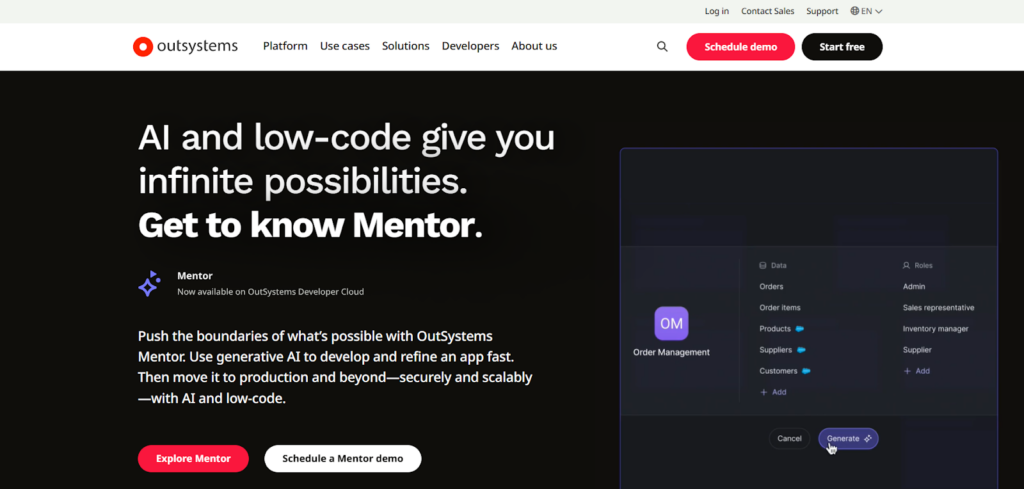
OutSystems is a robust platform that provides all the necessary tools for building, deploying, and managing mobile and web applications. It also supports the development of omnichannel enterprise solutions. Many well-known companies, including Warner Bros and Hewlett Packard, use OutSystems due to its ability to facilitate rapid and continuous app development. It enables efficient enterprise application management with built-in automation and scalability, making it a preferred choice for businesses looking for an effective development process.
Appian

Appian combines intelligent automation with a low-code platform to simplify complex development challenges and accelerate the app creation process. It offers pre-built connectors and APIs that simplify integration, allowing businesses to build highly functional mobile applications that enhance efficiency. Once the design phase is complete, Appian enables enterprise-wide deployment of apps across all mobile devices, making it a strong solution for organizations that need to optimize business processes through mobile technology.
Alpha Anywhere
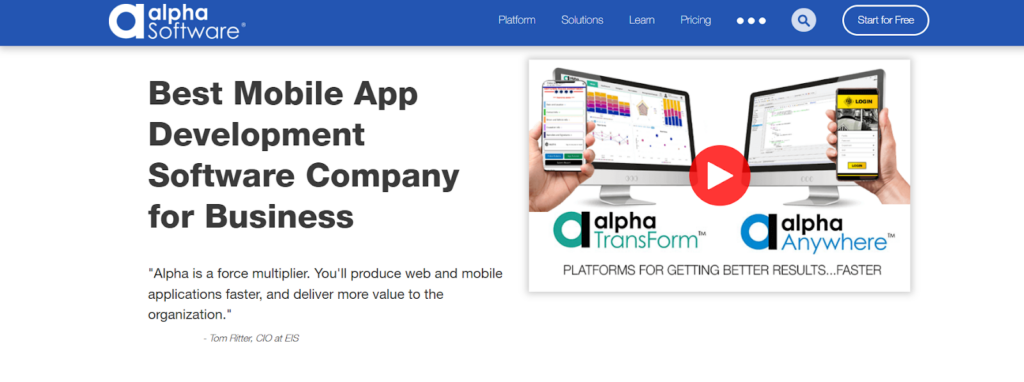
Alpha Anywhere is a unified development platform designed for both mobile and web applications. It includes Alpha TransForm, a built-in programming language that enhances development speed. In addition to development, Alpha Anywhere ensures secure app deployment with smooth integration into data sources, workflows, and other applications. It is particularly useful for both citizen developers and professional developers, as it allows for hand-coding when needed while maintaining a user-friendly interface.
No-Code App Development Platforms for Users Without Programming Experience
Creating a mobile application no longer requires coding expertise. Several no-code platforms provide intuitive tools that allow users to develop apps effortlessly. For those without prior programming experience, the following platforms offer a simple yet effective way to build smartphone applications.
AppSheet
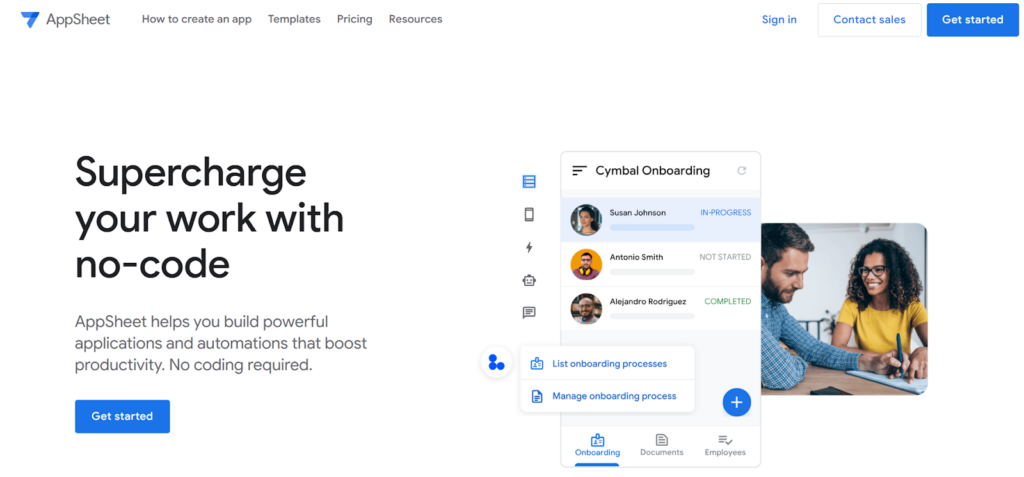
AppSheet enables users to create mobile applications using data sources such as Google Drive, cloud-based spreadsheets, and database platforms. This tool is widely used for handling business challenges, including project management, field inspections, and customized reporting. With its no-code functionality, AppSheet allows users to build apps without any prior coding knowledge. Features like multi-platform support, data integration, and data visualization make it a popular choice for businesses looking to simplify operations with custom-built applications.
BuildFire
BuildFire is a user-friendly app builder that requires no coding for mobile app development. As a do-it-yourself platform, it is designed for non-programmers who need a quick and efficient way to create custom applications. Users can either build an app from scratch by dragging and dropping elements or customize one of the available pre-built templates. Known for its flexibility and ease of use, BuildFire is currently supporting over 10,000 apps, making it a reliable option for businesses looking to develop functional mobile applications without extensive development efforts.
Conclusion
Selecting the right mobile web development tools is essential for building efficient, high-performing applications. These tools help developers simplify coding, testing, and deployment while ensuring compatibility across different platforms. Whether focusing on native app development, cross-platform solutions, or low-code frameworks, the choice of tools should align with project requirements and long-term goals.
The tools discussed in this article provide a range of functionalities, from integrated development environments and UI toolkits to automation platforms and testing frameworks. Each option has specific strengths, making it important to assess factors like scalability, performance, and integration capabilities before making a decision. With the right development tools, teams can enhance productivity, reduce development time, and maintain a reliable mobile application that meets user expectations.
Posted in blog, Web Applications
Alex Carter
Alex Carter is a cybersecurity enthusiast and tech writer with a passion for online privacy, website performance, and digital security. With years of experience in web monitoring and threat prevention, Alex simplifies complex topics to help businesses and developers safeguard their online presence. When not exploring the latest in cybersecurity, Alex enjoys testing new tech tools and sharing insights on best practices for a secure web.
